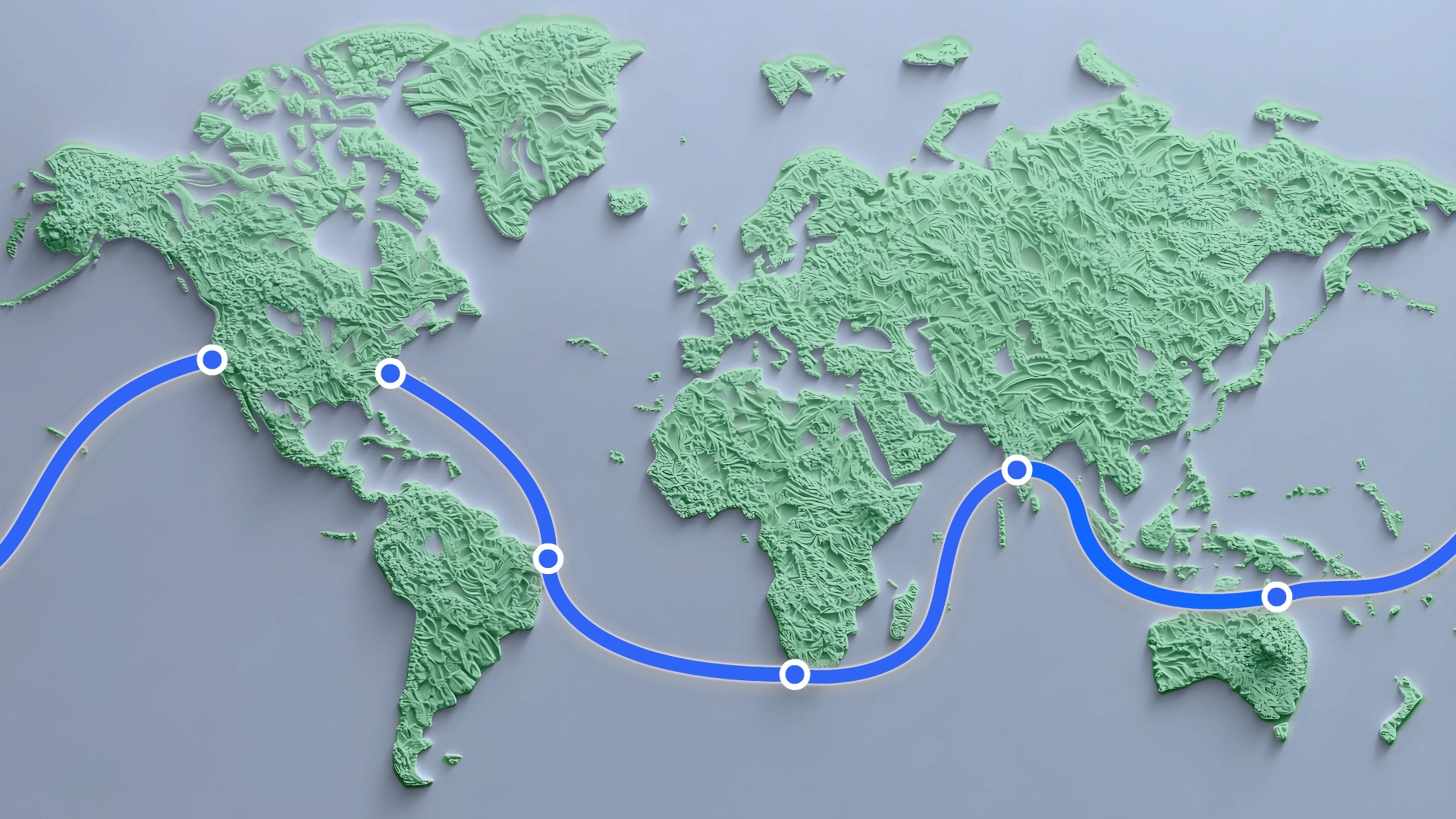Over the weekend, Facebook owner Meta announced “Project Waterworth,” an ambitious plan to build out a globe-spanning, 31,000-mile subsea internet cable. That’s longer from end to end than the circumference of the Earth. When completed, the massive cable is expected to connect the US, Brazil, South Africa, India, and other regions along the route. The project represents the latest push by Big Tech companies to control a greater share of subsea cable infrastructure. That general shift in who maintains the internet’s “pipes” could shift even further with the heightened data demands introduced by competition over advanced AI.
Though Meta did not provide specific details about the exact locations of its routes, a graphic shows a winding trail that begins on the US East Coast, moves down to South America, and travels across the lower Atlantic Ocean before making its way back up to India. The final stretch of the cable crosses all the way along the Pacific Ocean back to a port on the US West Coast. It’s still unclear exactly how much Project Waterworth will cost (Meta simply said it’s expecting a “multi-billion-dollar” investment). Previous rumors reported by TechCrunch in November, however, claimed Meta was prepared to spend $10 billion on a globe-spanning undersea cable project that seems to match Waterworth’s description. A Meta spokesperson told Popular Science they anticipate the project could finish construction “toward the end of this decade.”
This isn’t Meta’s first foray into subsea connectivity. The company has reportedly had a hand in at least 20 different cable projects over the past decade. These new cables, however, are being built specifically with artificial intelligence in mind. Project Waterworth will utilize a 24-fiber-pair system that Meta claims will be particularly useful for more data-intensive AI projects. For comparison, many smaller subsea cables will typically only have 8 to 16 fiber pairs.
“As AI continues to transform industries and societies around the world, it’s clear that capacity, resilience, and global reach are more important than ever to support leading infrastructure,” Meta network executives Nagarajan and Aimé said in a statement.
Meta is also making an effort to protect its investment from the elements. The company says it will lay cable up to 7,000 meters deep and use “enhanced burial techniques” to avoid damage from ship anchors and other hazards. Unwanted damage to cables is top of mind. In January, NATO launched an initiative to increase surveillance of ships crossing the Baltic Sea after a pair of suspicious instances where anchors damaged cables and sparked outages. But cables are also severed by less mundane culprits like natural disasters and sharks.
Related: [The mystery surrounding two severed Baltic subsea internet cables is getting murkier]
When completed, Meta says Project Waterworth could increase global cooperation between the connected countries and accelerate economic development, particularly in lower-income regions positioned along its routes. At least some countries are optimistic. This week, the United States and India released a joint statement praising the initiative, which they believe could “strengthen global digital highways in the Indian Ocean region and beyond.”
“India intends to invest in maintenance, repair and financing of undersea cables in the Indian Ocean, using trusted vendors,” the countries said in the statement.
But expansion cable projects like these also come with some concerns. Some marine scientists say it remains unclear what long-term effects electromagnetic fields generated by cables may have on marine life health. There are possible political complications to consider as well. In 2020, Meta (then called Facebook) and Google were forced to abandon plans to build out an undersea cable connecting the US to Hong Kong after US security agencies warned it could possibly become a target of Chinese government spying.
US tech companies are consolidating subsea cables ahead of AI push
Meta isn’t the only US tech company spending big on subsea cables. Just last year, Google announced plans to invest over $1 billion to build out new fiber connecting the US to Japan and other parts of the Pacific. The company also started work on a pair of cables around Australia. Amazon, which has also increased its involvement with internet infrastructure projects in recent years, is reportedly looking to build out new trans-Atlantic fiber connecting the US to Ireland. Overall, companies like Meta, Microsoft, Google, and Amazon and cloud service providers reportedly contributed to more than 60 subsea cables by the end of 2024. That’s up from just around 20 they were involved in building in 2017, according to research group TeleGeography. Content providers like Google, Facebook, Amazon, and Microsoft owned or leased more than half of undersea bandwidth by 2018.
That trend is expected to continue. Global technology consulting firm Analysys Mason recently released a 2024 forecast estimating that the global submarine fiber-optic telecom cable market will increase from $7.96 billion in 2023 to $9.8 billion by 2029, with “significant market growth” coming from a handful of so-called “hyperscalers” like Meta. A portion of that growth will be fueled by increasing data demands related to advanced AI models. Countries worldwide are rushing to build up massive data and other physical infrastructure needed to support all that computing. None of that will ultimately matter in the long term if there isn’t sufficient fiber capacity to transmit all that data around the globe.


